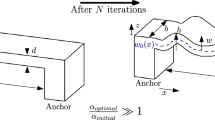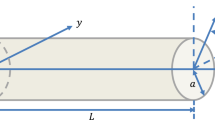Abstract
This paper analytically investigates the dynamic evolution of the primary frequency response of a prebuckling microbeam-based resonator with \(\hbox {Z}_{2}\) symmetry. A doubly clamped straight microbeam actuated by two symmetric stationary electrodes is simplified as a time-varying capacitor model for qualitative analysis purpose. Nonlinearities induced by the midplane stretching of the microbeam and the electrostatic force are considered. During solution procedure, electrostatic force holds its original form without any Taylor series expansion, and only one assumption with a small ratio of AC to DC voltage is introduced. The average equation, frequency response, backbone curve and stability condition are determined, respectively, based on the method of multiple scales combined with homotopy concept. Results demonstrate for the first time that the frequency response includes two types of branches, namely low- energy branch and high-energy branch. As the increase ion AC excitation amplitude, both branches close to each other along the backbone curve until they intersect. Further analyses are then performed to investigate the details of the backbone curve and the frequency response equation. Analytical formulas to determine the hardening and softening switches of the frequency response and the intersection condition of the low- and high-energy branches are both deduced and examined in depth. Primary frequency response properties in pull-in and secondary pull-in case are classified and depicted through theoretical predictions via the method of multiple scales and then verified through numerical results via the finite difference method combined with Floquet theory. Finally, a specific case study based on equivalent lumped parameters via Galerkin method is presented. Excellent agreements between theoretical predictions and simulation results illustrate the effectiveness of the whole analyses.


















Similar content being viewed by others
References
Younis, M.I.: MEMS Linear and Nonlinear Statics and Dynamics. Springer, NewYork (2011)
Lee, K.B.: Principles of Microelectromechanical Systems. Wiley, Hoboken (2011)
Zhang, W.M., Yan, H., Peng, Z.K., Meng, G.: Electrostatic pull-in instability in MEMS/NEMS: a review. Sens. Actuators A Phys. 214, 187–218 (2014)
Leus, V., Elata, D.: On the dynamic response of electrostatic MEMS switches. J. Microelectromech. Syst. 17, 236–243 (2008)
Kacem, N., Hentz, S., Pinto, D., Reig, B., Nguyen, V.: Nonlinear dynamics of nanomechanical beam resonators: improving the performance of NEMS-based sensors. Nanotechnology 20, 275501 (2009)
Najar, F., Choura, S., Elborgi, S., Abdelrahman, E.M., Nayfeh, A.H.: Modeling and design of variable-geometry electrostatic microactuators. J. Micromech. Microeng. 15, 419–429 (2005)
Hammad, B.K., Abdel-Rahman, E.M., Nayfeh, A.H.: Modeling and analysis of electrostatic MEMS filters. Nonlinear Dyn. 60, 385–401 (2010)
Nayfeh, A.H., Younis, M.I.: Dynamics of MEMS resonators under superharmonic and subharmonic excitations. J. Micromech. Microeng. 15, 1840–1847 (2005)
Nayfeh, A.H., Younis, M.I., Abdel-Rahman, E.M.: Dynamic pull-in phenomenon in MEMS resonators. Nonlinear Dyn. 48, 153–163 (2007)
Bouchaala, A., Nayfeh, A.H., Jaber, N., Younis, M.I.: Mass and position determination in MEMS mass sensors: a theoretical and an experimental investigation. J. Micromech. Microeng. 26, 105009 (2016)
Li, L., Zhang, Q.C.: Nonlinear dynamic analysis of electrically actuated viscoelastic bistable microbeam system. Nonlinear Dyn. 87, 587–604 (2017)
Li, L., Zhang, Q.C., Wang, W., Han, J.X.: Dynamic analysis and design of electrically actuated viscoelastic microbeams considering the scale effect. Int. J. Nonlinear Mech. 90, 21–31 (2017)
Han, J.X., Zhang, Q.C., Wang, W.: Static bifurcation and primary resonance analysis of a MEMS resonator actuated by two symmetrical electrodes. Nonlinear Dyn. 80, 1585–1599 (2015)
Cacan, M.R., Leadenham, S., Leamy, M.J.: An enriched multiple scales method for harmonically forced nonlinear systems. Nonlinear Dyn. 78, 1205–1220 (2014)
Krylov, S., Harari, I., Cohen, Y.: Stabilization of electrostatically actuated microstructures using parametric excitation. J. Micromech. Microeng. 15, 1188–1204 (2005)
Mobki, H., Rezazadeh, G., Sadeghi, M., Vakili-Tahami, F., Seyyed-Fakhrabadi, M.M.: A comprehensive study of stability in an electro-statically actuated micro-beam. Int. J. Nonlinear Mech. 48, 78–85 (2013)
Rhoads, J.F., Shaw, S.W., Turner, K.L.: The nonlinear response of resonant microbeam systems with purely-parametric electrostatic actuation. J. Micromech. Microeng. 16, 890–899 (2006)
Mestrom, R.M.C., Fey, R.H.B., van Beek, J.T.M., Phan, K.L., Nijmeijer, H.: Modelling the dynamics of a MEMS resonator: simulations and experiments. Sens. Actuators A Phys. 142, 306–315 (2008)
Mestrom, R.M.C., Fey, R.H.B., Phan, K.L., Nijmeijer, H.: Simulations and experiments of hardening and softening resonances in a clamped-clamped beam MEMS resonator. Sens. Actuators A Phys. 162, 225–234 (2010)
Rezazadeh, G., Madinei, H., Shabani, R.: Study of parametric oscillation of an electrostatically actuated microbeam using variational iteration method. Appl. Math. Model. 36, 430–443 (2012)
Dai, L., Sun, L., Chen, C.: A control approach for vibrations of a nonlinear microbeam system in multi-dimensional form. Nonlinear Dyn. 77, 1677–1692 (2014)
Barceló, J., Rosselló, J.L., Bota, S., Segura, J., Verd, J.: Electrostatically actuated microbeam resonators as chaotic signal generators: a practical perspective. Commun. Nonlinear Sci. Numer. Simul. 30, 316–327 (2016)
Han, J.X., Zhang, Q.C., Wang, W., Jin, G., Li, B.Z.: Stability and perturbation analysis of a one-degree-of-freedom doubly clamped microresonator with delayed velocity feedback control. J. Vib. Control. https://doi.org/10.1177/1077546317706886 (2017)
Younesian, D., Sadri, M., Esmailzadeh, E.: Primary and secondary resonance analyses of clamped-clamped micro-beams. Nonlinear Dyn. 76, 1867–1884 (2014)
Bouchaala, A., Jaber, N., Yassine, O., Shekhah, O., Chernikova, V., Eddaoudi, M., Younis, M.I.: Nonlinear-based MEMS sensors and active switches for gas detection. Sensors 16, 758 (2016)
Abdel-Rahman, E.M., Nayfeh, A.H.: Secondary resonances of electrically actuated resonant microsensors. Nonlinear Dyn. 13, 491–501 (2003)
Zamanzadeh, M., Rezazadeh, G., Jafarsadeghi-poornaki, I., Shabani, R.: Static and dynamic stability modeling of a capacitive FGM micro-beam in presence of temperature changes. Appl. Math. Model. 37, 6964–6978 (2013)
Azizi, S., Ghazavi, M.R., Khadem, S.E., Rezazadeh, G., Cetinkaya, C.: Application of piezoelectric actuation to regularize the chaotic response of an electrostatically actuated micro-beam. Nonlinear Dyn. 73, 853–867 (2013)
Tusset, A.M., Balthazar, J.M., Bassinello, D.G., Pontes, B.R., Felix, J.L.P.: Statements on chaos control designs, including a fractional order dynamical system, applied to a “MEMS” comb-drive actuator. Nonlinear Dyn. 69, 1837–1857 (2012)
Towfighian, S., G.R., Heppler, Abdel-Rahman, E.M.: Analysis of a chaotic electrostatic micro-oscillator. J. Comput. Nonlinear Dyn. 6, 011001 (2011)
Luo, A.C.J., Wang, F.Y.: Chaotic motion in a micro-electro-mechanical system with non-linearity from capacitors. Commun. Nonlinear Sci. Numer. Simul. 7, 31–49 (2002)
Alsaleem, F.M., Younis, M.I.: Stabilization of electrostatic MEMS resonators using a delayed feedback controller. Smart Mater. Struct. 19, 035016 (2010)
Lakrad, F., Belhaq, M.: Suppression of pull-in instability in MEMS using a high-frequency actuation. Commun. Nonlinear Sci. Numer. Simul. 15, 3640–3646 (2010)
Gutierrez, A., Torres, P.J.: Nonautonomous saddle-node bifurcation in a canonical electrostatic MEMS. Int. J. Bifurcat. Chaos. 23, 1350088 (2013)
Tajaddodianfar, F., Yazdi, M.R.H., Pishkenari, H.N.: Nonlinear dynamics of MEMS/NEMS resonators: analytical solution by the homotopy analysis method. Microsyst. Technol. 23, 1913–1926 (2017)
Miandoab, E.M., Yousefi-Koma, A., Pishkenari, H.N., Tajaddodianfar, F.: Study of nonlinear dynamics and chaos in MEMS/NEMS resonators. Commun. Nonlinear Sci. Numer. Simul. 22, 611–622 (2015)
Han, J.X., Zhang, Q.C., Wang, W.: Design considerations on large amplitude vibration of a doubly clamped microresonator with two symmetrically located electrodes. Commun. Nonlinear Sci. Numer. Simul. 22, 492–510 (2015)
Elshurafa, A.M., Khirallah, K., Tawfik, H.H., Emira, A.: Nonlinear dynamics of spring softening and hardening in folded-MEMS comb drive resonators. J. Microelectromech. Syst. 20, 943–958 (2011)
Nayfeh, A.H., Mook, D.T.: Nonlinear Oscillations. Wiley, New York (2008)
Han, J.X., Qi, H.J., Jin, G., Li, B.Z., Feng, J.J., Zhang, Q.C.: Mechanical behaviors of electrostatic microresonators with initial offset imperfection: qualitative analysis via time-varying capacitors. Nonlinear Dyn. https://doi.org/10.1007/s11071-017-3868-4 (2017)
Nayfeh, A.H., Balachandran, B.: Applied Nonlinear Dynamics. Wiley, New York (1995)
Li, L., Zhang, Q.C., Wang, W., Han, J.X.: Monostable dynamic analysis of microbeam-based resonators via an improved one degree of freedom model. Micromachines (2018). https://doi.org/10.3390/mi9020089
Pasharavesh, A., Ahmadian, M.T.: Characterization of a nonlinear MEMS-based piezoelectric resonator for wideband micro power generation. Appl. Math. Model. 41, 121–142 (2017)
Madinei, H., Haddad Khodaparast, H., Adhikari, S., Friswell, M.I.: Design of MEMS piezoelectric harvesters with electrostatically adjustable resonance frequency. Mech. Syst. Signal Process. 81, 360–374 (2016)
Madinei, H., Haddad Khodaparast, H., Adhikari, S., Friswell, M.I., Fazeli, M.: Adaptive tuned piezoelectric MEMS vibration energy harvester using an electrostatic device. Eur. Phys. J. 224, 2703–2717 (2015)
Najar, F., Nayfeh, A.H., Abdel-Rahman, E.M., Choura, S., El-Borgi, S.: Nonlinear analysis of MEMS electrostatic microactuators: primary and secondary resonances of the first mode. J. Vib. Control 16, 1321–1349 (2010)
Acknowledgements
This work was supported by the National Natural Science Foundation of China (Grant Nos. 11702192, 51505336, 11772218, 11602173, 11602169), Tianjin Research Program of Application Foundation and Advanced Technology (Grant Nos. 15JCQNJC05200, 16JCQNJC04700), Innovation Team Training Plan of Tianjin Universities and colleges (Grant No. TD13-5096), Tianjin Science and Technology Planning Project (Grant No. 15ZXZNGX00220), Scientific Research Program of Tianjin Education Committee (Grant No. JWK1602) and the Scientific Research Foundation of Tianjin University of Technology and Education (Grant Nos. KYQD16009, KYQD1701).
Author information
Authors and Affiliations
Corresponding author
Ethics declarations
Conflict of interest
The authors declare that they have no conflict of interest.
Appendix
Appendix
1.1 Appendix A
The derivation of the secular term via the method of multiple scales combined with the residue theorem can be described as follows.
We denote the right side of Eq. (10) as
where
The secular term in Eq. (A.1) can be calculated through the following average process
where \(\varphi =\omega T_0 +\beta (T_1 )\).
We can easily derive the integration of the first term in Eq. (A.5) as
The integration of the next two terms in Eq. (A.5) can be solved based on residue theorem. One can introduce the following variable
The trigonometric functions \(\sin \varphi \) and \(\cos \varphi \) can be written as
Then, the integration of the second term in Eq. (A.5) can be rewritten as
Applying the residue theorem, one can obtain
Similarly, one can derive the third integration in Eq. (A.5) as follows
Finally, the secular term can be expressed as
Separating the imaginary and real parts can derive the average equation Eq. (12).
1.2 Appendix B
The coefficients in Eq. (15) are as follows
The coefficients in Eq. (16) are as follows
Rights and permissions
About this article
Cite this article
Han, J., Jin, G., Zhang, Q. et al. Dynamic evolution of a primary resonance MEMS resonator under prebuckling pattern. Nonlinear Dyn 93, 2357–2378 (2018). https://doi.org/10.1007/s11071-018-4329-4
Received:
Accepted:
Published:
Issue Date:
DOI: https://doi.org/10.1007/s11071-018-4329-4




